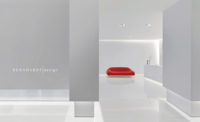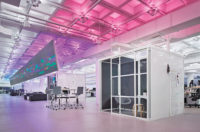Problem: Turn blank space into a lively, social hub for Brooklyn preschoolers.
Solution: Direct the flow of traffic from adjacent classrooms and the entry to a central area with an open kitchen modeled after New York food trucks.
The two-, three- and four-year-olds enrolled at Maple Street School in Brooklyn are expected to develop more than cognitive and fine motor skills. Parents at the cooperatively owned preschool also want their children to learn positive ways to socialize.
Before the chance to expand in a second location one block away, the school drove home these social lessons entirely with meal routines. But a new second-floor location in a LEED-certified, mixed-use building by Marvel Architects offered the chance to also enlist design as a teaching tool. Maple Street asked Barker Freeman Design Office (BFDO) and 4Mativ Design Studio how the space could promote their social program. Specifically, it needed to support frequent “café time”—social gatherings centered on snacks.
“We had all these conversations about this café activity and started brainstorming about how the kitchen could be configured to add an element of fun,” says BFDO principal Alexandra Barker.
Barker’s team responded with an agile plan for the 3,300-square-foot space: three interconnected classrooms arranged around a central open area containing cubbies, play space, and a kitchen with a twist. “All the children pass through this communal gathering space to store their belongings before entering classrooms. So, a kitchen in the center is a natural gathering point,” Barker says. To make it fun, the team brainstormed a few social settings Brooklyn kids could identify with and came up with one: “Food trucks are familiar places for informal gathering in Brooklyn,” Barker says.
Having made that connection, the architects built the classroom equivalent—complete with a galley kitchen, service window, Plexiglass menu boards, and a drop-down counter that sits two feet high, the perfect height for tiny customers to pull up to (dinerstyle) for snacks. The compact kitchen is enclosed on either side by locking doors for the children’s safety, but remains open via the service window overlooking the comings and goings in the shared common space.
With café time handled, BFDO turned to the rest of the school’s wishlist of natural light, views, and outdoor play space.
Compared with the first street-level location, the new second-floor site could accommodate a row of glass window doors with transoms to take advantage of treelined views and ample light along the northeast wall where two of the three classrooms sit. Oval apertures at child and adult heights punctuate sliding pocket doors that can partition the classrooms from each other—and from the shared space—or roll back to combine the rooms. The material palette inside is simple, spare, and appropriate—maple flooring, doors, and furnishings.
Roof access allowed for an outdoor classroom and play area with rubber tiles underfoot and a combination of cedar and perforated aluminum safety fencing.
Since pre-k bathrooms are public spaces where teachers passively supervise potty-training, architects envisioned another way design could help: They enclosed them in bluetiled walls that stop well below the ceiling and have a pass-through cut out over the lav, allowing a partial view inside and use of the sinks from the classroom-facing side of the wall.







